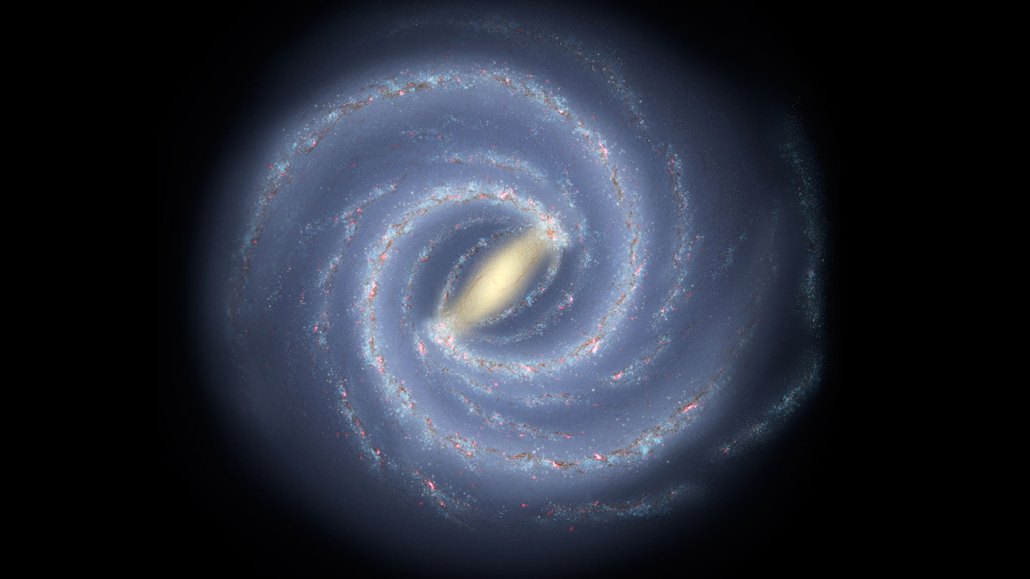Spin in this Milky Way bar may show cosmic dark matter does exist
A cosmic equivalent to tree rings hints at how that spin slowed over time

This illustration of our Milky Way shows a central bar of stars (yellow) that rotates along with the galaxy. Researchers reported evidence that the bar is being slowed by the presence of dark matter.
R. Hurt/JPL-Caltech/NASA, ESO
Share this:
- Share via email (Opens in new window) Email
- Click to share on Facebook (Opens in new window) Facebook
- Click to share on X (Opens in new window) X
- Click to share on Pinterest (Opens in new window) Pinterest
- Click to share on Reddit (Opens in new window) Reddit
- Share to Google Classroom (Opens in new window) Google Classroom
- Click to print (Opens in new window) Print
Dark matter can be a real drag. The pull of that unidentified, invisible matter in our galaxy may be slowing down a rotating bar of stars at the heart of our Milky Way.
Scientists used a technique to recreate a timeline for this slowdown. The approach works somewhat like figuring out a tree’s age by counting rings in the trunk. This technique finds the bar’s speed has slowed by at least 24 percent since it formed, billions of years ago.
That slowdown is “another indirect — but important — piece of evidence that dark matter is a thing,” says astrophysicist Martin Weinberg. He works at the University of Massachusetts Amherst. Scientists have long suspected that dark matter exists, even though they can’t see it. The new slowdown is a sign of dark matter, Weinberg says. After all, he points out, “this [slowdown] can’t happen without it.”
Many spiral galaxies, including our Milky Way, contain a central bar-shaped region. It is densely packed with stars. Surrounding it are the galaxy’s pinwheeling arms. The bar also has some groupies: a crew of stars. They sit alongside the bar but farther out from the galaxy’s center. They’re trapped by the bar’s gravitational influence. Those stars orbit about a gravitationally stable site known as a so-called Lagrange point.
If the bar’s rotation slows, it will grow in length. The bar’s tagalongs will also move outward. As that happens, that group of hangers-on will gather even more stars. According to a computer model of this process, those additional stars should arrange themselves in layers on the outside of the group, says Ralph Schönrich. He’s an astrophysicist at University College London in England. The layers of stars serve as a record of the group’s growth. “It’s actually like a tree that you can cut up in your own galaxy,” he says.
Schönrich and Rimpei Chiba of the University of Oxford in England studied how the composition of stars in the group changed from its outer edge to its deeper layers.
Different parts of the Milky Way have different types of stars. Some parts of the galaxy have stars containing hydrogen and helium and not much else. Other parts of the galaxy have stars with heavier chemical elements. By looking at the composition of the layers in the group of stars, the scientists could tell where the group picked up the layers.
They worked with data from the European Space Agency’s Gaia spacecraft. Stars in the outer layers of the bar tend to have few elements heavier than helium, their work revealed. The inner layer’s stars have more of those heavy elements. That’s evidence, they say, that the group of stars is moving outward due to the bar slowing. The group picked up stars of different compositions as it moved along.
The bar’s slowdown hints that a gravitational force is acting on it. Namely, dark matter in the galaxy seems to be pulling on that bar of stars. Normal matter alone wouldn’t have enough mass to reduce the bar’s speed. “If there is no dark matter, the bar will not slow down,” Chiba says.
He and Schönrich describe their finding in the August Monthly Notices of the Royal Astronomical Society.
But the results have some critics. “This is not yet convincing to me,” says astrophysicist Isaac Shlosman. He works at the University of Kentucky in Lexington. For instance, he doubts that the tree-ring layering would really occur. It is “hard to believe that this is the case in a realistic system” as opposed to in a simple computer model, he says.
Weinberg, in contrast, says that although the study relies on many assumptions, he suspects it’s correct. “It’s got the right smell,” he says.







